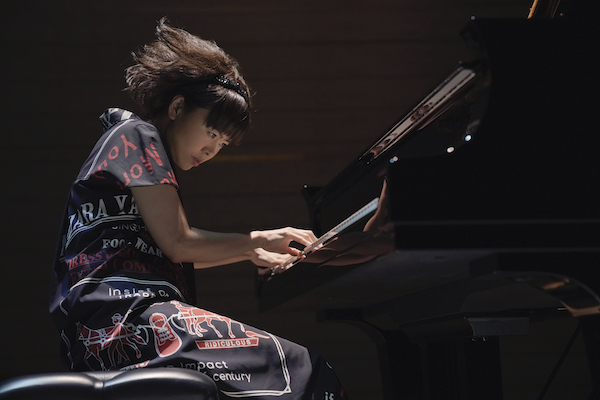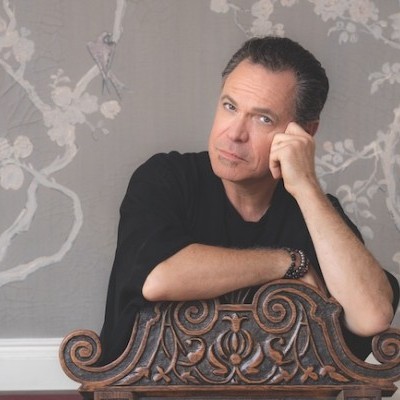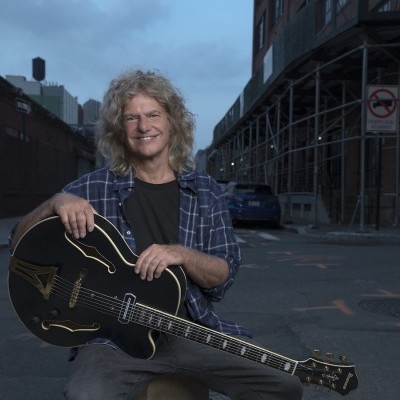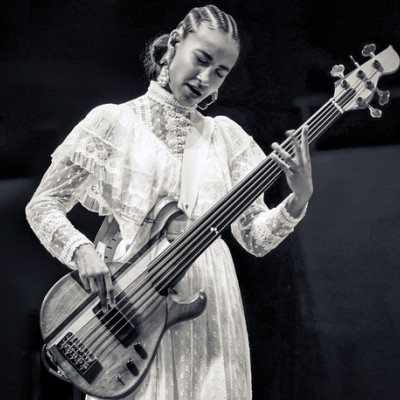Oct 28, 2025 10:47 AM
In Memoriam: Jack DeJohnette, 1942–2025
Jack DeJohnette, a bold and resourceful drummer and NEA Jazz Master who forged a unique vocabulary on the kit over his…

Hiromi’s diverse discography includes collaborations with pianist Chick Corea and harpist Edmar Castaneda.
(Photo: Makoto Hirose)For Hiromi, the urge to put her stamp on notated works was noticed early on, as was her affinity for solo performance. The latter revealed itself at age 6, when, as a recitalist in the Japanese coastal city of Hamamatsu, she won praise from her teacher for her poise at the keyboard. “I remember her saying, ‘You play better onstage than in the practice room,’” Hiromi recalled.
Her irrepressible inventiveness, meanwhile, became obvious in the practice room. Taking to the woodshed the way other children took to video games, she said, she had, by age 8, been exposed to Peterson and Garner, and, in the years that followed, begun turning Hanon exercises—the mechanistic sine qua non of piano pedagogy—into swinging vehicles for improvisation.
Her penchant for syncopating the classical literature spread to pieces like Beethoven’s Sonata No. 8, the “Pathétique.” “I was reading the piece as most of the students do,” she said. “But then, because I would listen to so much jazz, I was introduced to a different flavor of chords. I wanted to add some tensions—so I added sus chords.”
Hiromi never stopped experimenting with the sonata. She uses its adagio—one of Beethoven’s purest melodies—as a delicately rendered jumping-off point for a slightly kicky jazz ballad that closes 2011’s Voice (Telarc), the first of four trio albums she recorded with bassist Anthony Jackson and drummer Simon Phillips.
Phillips recalled that he used brushes on the tune, an experience he did not often have in decades of playing with rockers like Jack Bruce, Jeff Beck and The Who. Not that brushes were his go-to choice with Hiromi, whose appreciation for said musicians was amply reflected in her trio concept.
“She’s a huge fan of all those people,” he said. “She has a huge listening curve.”
Unaware of her fondness for high-voltage music, he was surprised when in 2010 Hess-Hay called to recruit him for Hiromi’s trio. “I said, ‘Really?’ She said, ‘Yes, and it would be you and Anthony Jackson.’ I said, ‘That would be interesting. But are you aware of what I play, my drum kit? It’s like a rock ’n’ roll drum kit.’ She said, ‘Hiromi wants that.’ And that’s how the whole thing started.”
The experience, he said, was liberating, especially compared with some small-group situations he’s encountered outside the rock world. “I’ve always been fairly bombastic, energetic, looking for a different way around playing things. A lot of people tend to be a little more reserved. So, in a lot of lineups, I’ve had to curb my enthusiasm, as it were. With her, it was like all the gates were open. Off you go. What I loved was the challenge.”
The challenge, Bishop said, actually worked both ways. Hiromi’s original trios had mostly been composed of personal friends from Berklee. “Then she made the leap to recording exclusively with Anthony and Simon. That took everything to a much higher level of discipline as far as the attitude toward the work. She was learning a lot from Anthony and Simon, who had much broader experience. But their challenge was that they had never played with anybody like her. So, they had to up their game to keep up.”
Before hiring them, Hiromi was well aware of both Phillips and Jackson, who had performed with everyone from Chick Corea to singer Chaka Khan, and played on two of Phillips’ albums—Force Majeure (1992) and Another Lifetime (1999). “Simon and Anthony were complete musicians—very strong musicians with strong characteristics,” she said. “So, I composed songs imagining them playing. I had them in my mind. This made the trio really powerful.”
Part of the power came from the sense of possibility Hiromi engendered. For touring, she said, she viewed her arrangements “like a blueprint; the structure can change freely.” Phillips fancied that attitude: “She was like, ‘I want to play all these songs for the new album, but we’re going to play one new song every set.’ We’d barely rehearsed. Talk about brave. Anthony and I would look at each other and go, ‘Which one is this?’ I would go, ‘Is this the one in 17 or the one in 5’? I loved it—I love playing dangerously.”
Before recording, Phillips was a bit more circumspect. He spent time studying Hiromi’s piano demo and PDF files of the music: “I would listen to them and look at the chart and go, ‘Part of it is playable, part of it is totally unplayable.’” At that point, he would fall into default mode. “Let’s say the chart’s in 7. I would just play the easiest pattern I could play. But then I’d listen to where the key points of the phrase are, in terms of that 7. Then when I’d listen to all the tunes coming in, I’d go, ‘Hmm. We’ve got three tunes in 7.’ This is where my production approach comes in. I’d look at one song and go, ‘I could play this normal or I could look for something totally different on this.’”
One tune in 7/4 on which he did the unexpected was “Take Me Away,” off the trio’s last album, 2016’s Spark (Telarc): “It’s almost a composed part, almost like a pop song. It’s almost like a sequence drum pattern. What I did to come up with that, I needed to just play around that particular groove. I took Pro Tools and I looped the first melody and I just started very sparsely. Maybe one kick beat. ‘Let’s see how the backbeat is going to hit; how does this feel?’ And in 20 minutes I had a part.”
The processing obviously worked, contributing as it did to four acclaimed albums. In addition, Phillips said, he played 346 live dates with Hiromi’s trio, from June 2011 to April 2017. The run, which included three tours of Japan, dispelled any early reservations. And, he admitted, there were some. At the first show, in San Francisco, he said, “I really still had my doubt as to how this was going to work in a live context.” But long before the final gig, at Parque Trasloma in Guadalajara, Mexico, he had become a true believer.
Bishop witnessed the way the trio jelled: “They really started working more as a flock of birds, turning instantly and going in opposite directions. They could just do anything; if she took it in another direction, they were with her and vice versa.”
That kind of simpatico has, to one degree or another, also characterized her duo collaborations, whether with keyboard monsters like Corea and Michel Camilo or, more recently, with harpist Edmar Castaneda.
The pairing of piano and harp, she said, constituted something of a delicate dance: “Each second, I’d try to avoid the range he’d play. Even in the improvisation, I was trying to understand where he plays chords, accompaniments.”
Castaneda, who also had collaborated with pianists like Gonzalo Rubalcaba, did not play down the challenges: “To mix harp with piano is very difficult. We have almost the same rules. If you open a piano, inside it’s a harp. You have so many notes and all the harmonics. You have to divide your roles. It’s very difficult to make space for everything.”
But from their first gig, at New York’s Blue Note in 2017, clashes were virtually nonexistent. Thrust onstage with no time to bond musically beyond a sound check, he said, “It sounded like we knew each other for years.” Hiromi was satisfied enough to book a tour with Castaneda that culminated in the 2017 duo album Live In Montreal (Telarc).
Despite—or, perhaps, because of—all the small-unit work she has been doing, Hiromi is, for the future, thinking big. Among her aspirations: “I want to push my big band writing.”
For the moment, however, she is embarking on a 50-city solo tour of Europe and the United States. And next August, according to Wein, Hiromi might be playing solo again at Newport. That is a prospect that, for Hiromi—a giant of pianism in a compact frame—hardly qualifies as thinking small: “There are many different projects I want to achieve.” DB

Jack DeJohnette boasted a musical resume that was as long as it was fearsome.
Oct 28, 2025 10:47 AM
Jack DeJohnette, a bold and resourceful drummer and NEA Jazz Master who forged a unique vocabulary on the kit over his…

“Think of all the creative people I’m going to meet and a whole other way of thinking about music and a challenge of singing completely different material than I would have sung otherwise to my highest level in dedication to the moment,” Elling says about his Broadway run.
Sep 9, 2025 1:18 PM
Kurt Elling was back at home in Chicago, grabbing some family time in a late-June window between gigs. Sporting a smile…

Pat Metheny will perform with his Side-Eye III ensemble at Big Ears 2026 in Knoxville, Tennessee, next March.
Sep 9, 2025 12:19 PM
Big Ears has announced the lineup for its 2026 festival, which will take place March 26–29 and include 250…

“[That’s] the thing of the beboppers,” Bradford said. “These guys were important for not only playing that wonderful music, but they knew a sort of social stance, you see?”
Sep 9, 2025 1:07 PM
It was a calm, balmy, near-perfect evening in Westwood, California, not far from UCLA, in the expansive courtyard at…

Esperanza Spalding closed an audacious Chicago Jazz Festival set with “Endangered Species.”
Sep 9, 2025 11:50 AM
The 45th Chicago Jazz Festival kicked off its headline events with two erudite individuals, Esperanza Spalding and…